Innovation Management Report: Sainsbury's Value Creation Analysis
VerifiedAdded on 2023/01/18
|12
|3903
|78
Report
AI Summary
This report delves into the realm of innovation management, focusing on its significance in today's global business environment, using Sainsbury's as a case study. It commences with an introduction to innovation management, defining its processes and importance for companies seeking competitive advantages. The methodology section outlines the approach used for the analysis, followed by a detailed discussion of findings. The report explores the role of innovation management in enhancing workplace productivity, improving customer sentiment, enriching competitive advantage, and optimizing operational efficiency within Sainsbury's. It examines the challenges faced at strategic, tactical, and operational levels, such as resistance to change, ineffective communication, and resource constraints. The report then presents and analyzes innovation management theories, including Schumpeter's theory and the open innovation model, and their application to Sainsbury's. It concludes with recommendations for addressing the identified challenges and fostering a successful innovation management culture. The report emphasizes the importance of clear communication, delegation of responsibilities, and strategic approaches to overcome barriers and drive sustainable growth. References are provided to support the analysis.
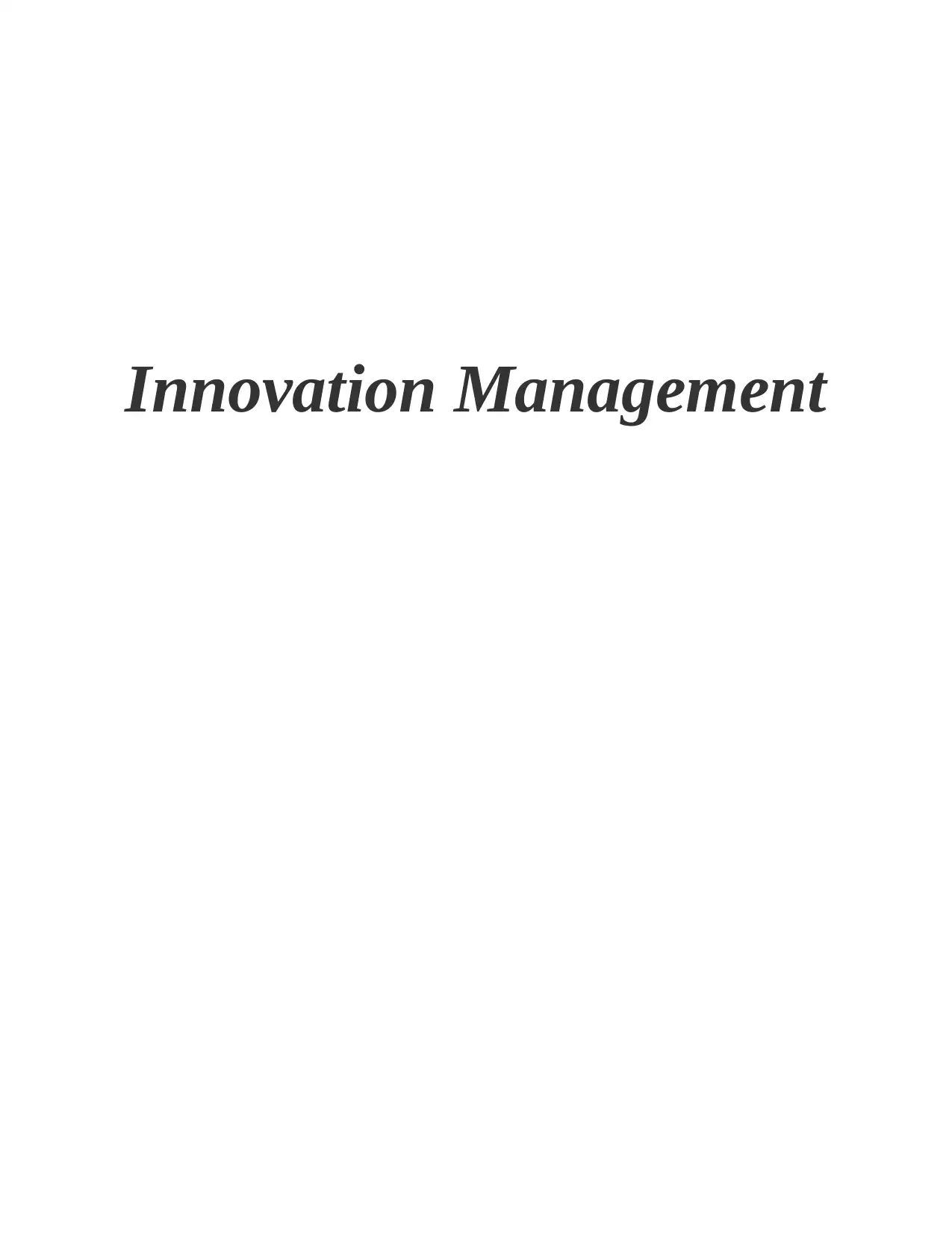
Innovation Management
Paraphrase This Document
Need a fresh take? Get an instant paraphrase of this document with our AI Paraphraser
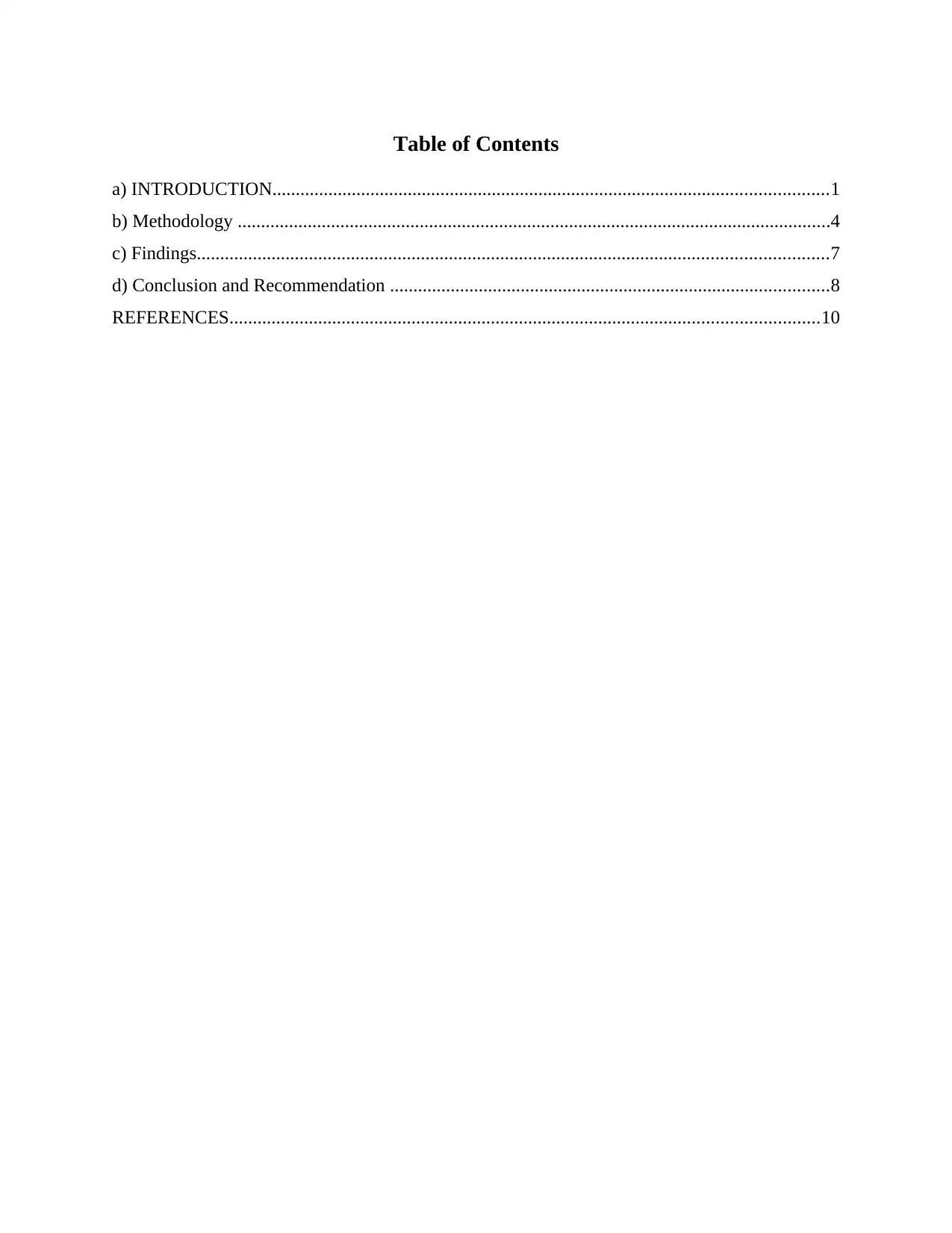
Table of Contents
a) INTRODUCTION.......................................................................................................................1
b) Methodology ...............................................................................................................................4
c) Findings.......................................................................................................................................7
d) Conclusion and Recommendation ..............................................................................................8
REFERENCES..............................................................................................................................10
a) INTRODUCTION.......................................................................................................................1
b) Methodology ...............................................................................................................................4
c) Findings.......................................................................................................................................7
d) Conclusion and Recommendation ..............................................................................................8
REFERENCES..............................................................................................................................10
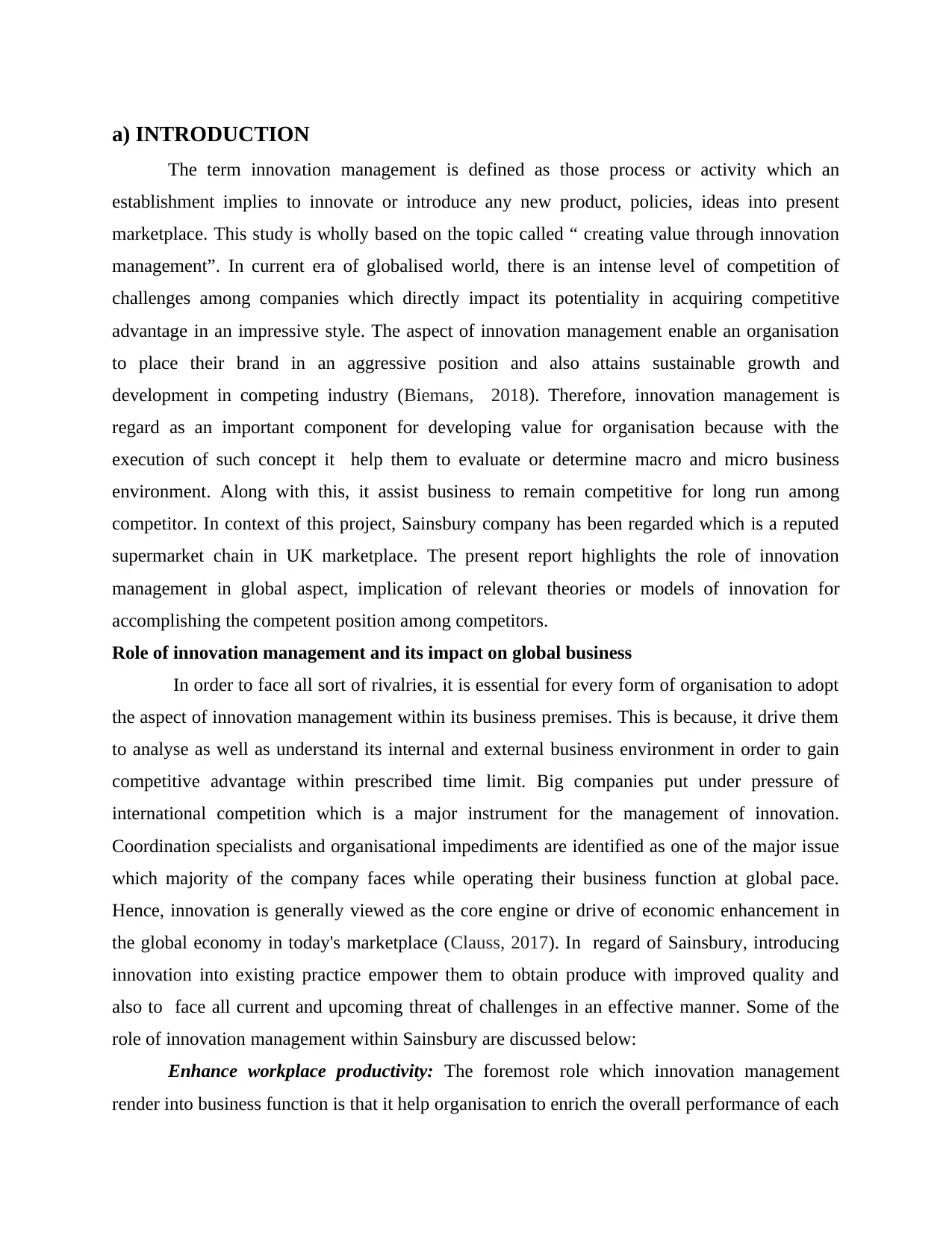
a) INTRODUCTION
The term innovation management is defined as those process or activity which an
establishment implies to innovate or introduce any new product, policies, ideas into present
marketplace. This study is wholly based on the topic called “ creating value through innovation
management”. In current era of globalised world, there is an intense level of competition of
challenges among companies which directly impact its potentiality in acquiring competitive
advantage in an impressive style. The aspect of innovation management enable an organisation
to place their brand in an aggressive position and also attains sustainable growth and
development in competing industry (Biemans, 2018). Therefore, innovation management is
regard as an important component for developing value for organisation because with the
execution of such concept it help them to evaluate or determine macro and micro business
environment. Along with this, it assist business to remain competitive for long run among
competitor. In context of this project, Sainsbury company has been regarded which is a reputed
supermarket chain in UK marketplace. The present report highlights the role of innovation
management in global aspect, implication of relevant theories or models of innovation for
accomplishing the competent position among competitors.
Role of innovation management and its impact on global business
In order to face all sort of rivalries, it is essential for every form of organisation to adopt
the aspect of innovation management within its business premises. This is because, it drive them
to analyse as well as understand its internal and external business environment in order to gain
competitive advantage within prescribed time limit. Big companies put under pressure of
international competition which is a major instrument for the management of innovation.
Coordination specialists and organisational impediments are identified as one of the major issue
which majority of the company faces while operating their business function at global pace.
Hence, innovation is generally viewed as the core engine or drive of economic enhancement in
the global economy in today's marketplace (Clauss, 2017). In regard of Sainsbury, introducing
innovation into existing practice empower them to obtain produce with improved quality and
also to face all current and upcoming threat of challenges in an effective manner. Some of the
role of innovation management within Sainsbury are discussed below:
Enhance workplace productivity: The foremost role which innovation management
render into business function is that it help organisation to enrich the overall performance of each
The term innovation management is defined as those process or activity which an
establishment implies to innovate or introduce any new product, policies, ideas into present
marketplace. This study is wholly based on the topic called “ creating value through innovation
management”. In current era of globalised world, there is an intense level of competition of
challenges among companies which directly impact its potentiality in acquiring competitive
advantage in an impressive style. The aspect of innovation management enable an organisation
to place their brand in an aggressive position and also attains sustainable growth and
development in competing industry (Biemans, 2018). Therefore, innovation management is
regard as an important component for developing value for organisation because with the
execution of such concept it help them to evaluate or determine macro and micro business
environment. Along with this, it assist business to remain competitive for long run among
competitor. In context of this project, Sainsbury company has been regarded which is a reputed
supermarket chain in UK marketplace. The present report highlights the role of innovation
management in global aspect, implication of relevant theories or models of innovation for
accomplishing the competent position among competitors.
Role of innovation management and its impact on global business
In order to face all sort of rivalries, it is essential for every form of organisation to adopt
the aspect of innovation management within its business premises. This is because, it drive them
to analyse as well as understand its internal and external business environment in order to gain
competitive advantage within prescribed time limit. Big companies put under pressure of
international competition which is a major instrument for the management of innovation.
Coordination specialists and organisational impediments are identified as one of the major issue
which majority of the company faces while operating their business function at global pace.
Hence, innovation is generally viewed as the core engine or drive of economic enhancement in
the global economy in today's marketplace (Clauss, 2017). In regard of Sainsbury, introducing
innovation into existing practice empower them to obtain produce with improved quality and
also to face all current and upcoming threat of challenges in an effective manner. Some of the
role of innovation management within Sainsbury are discussed below:
Enhance workplace productivity: The foremost role which innovation management
render into business function is that it help organisation to enrich the overall performance of each
⊘ This is a preview!⊘
Do you want full access?
Subscribe today to unlock all pages.

Trusted by 1+ million students worldwide
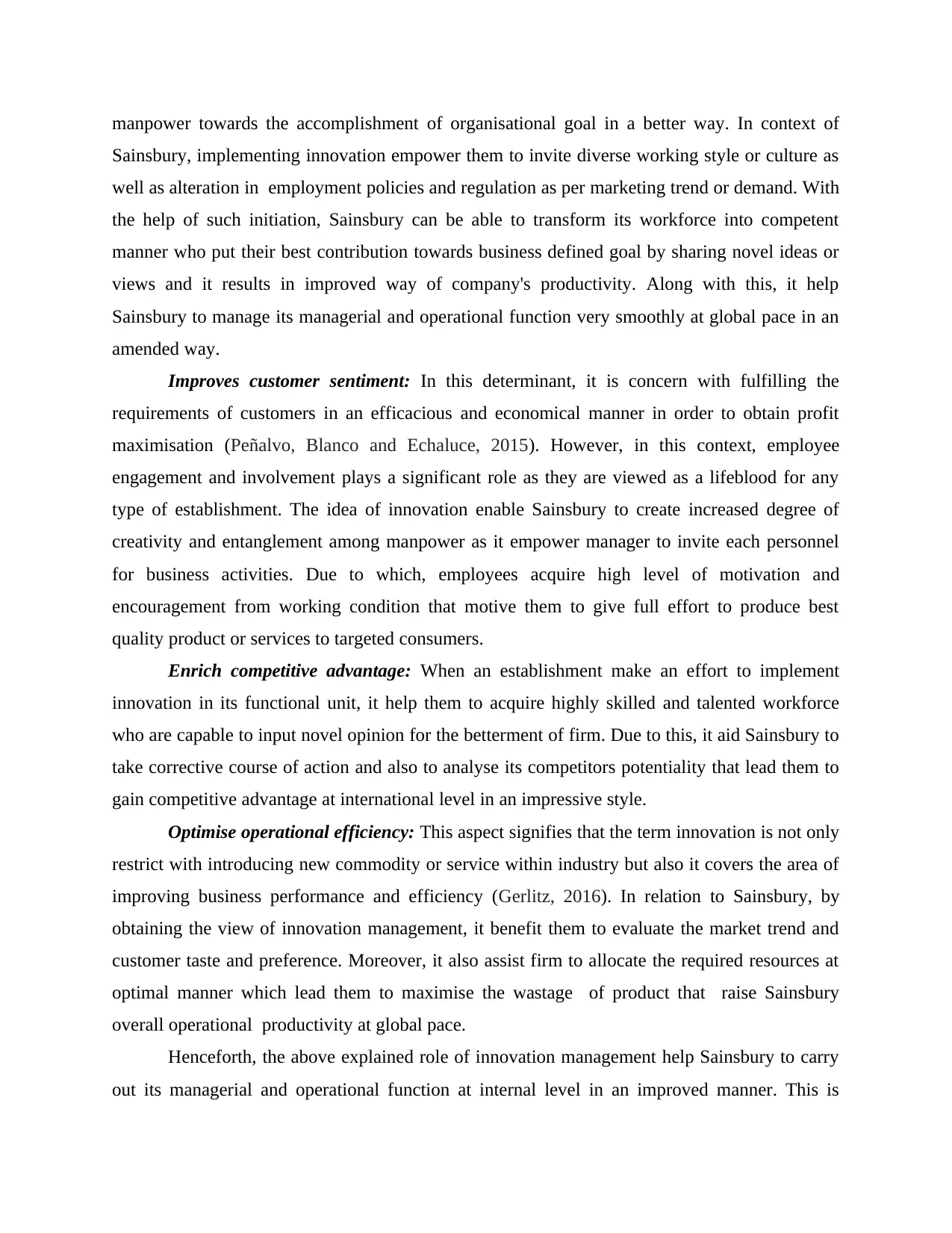
manpower towards the accomplishment of organisational goal in a better way. In context of
Sainsbury, implementing innovation empower them to invite diverse working style or culture as
well as alteration in employment policies and regulation as per marketing trend or demand. With
the help of such initiation, Sainsbury can be able to transform its workforce into competent
manner who put their best contribution towards business defined goal by sharing novel ideas or
views and it results in improved way of company's productivity. Along with this, it help
Sainsbury to manage its managerial and operational function very smoothly at global pace in an
amended way.
Improves customer sentiment: In this determinant, it is concern with fulfilling the
requirements of customers in an efficacious and economical manner in order to obtain profit
maximisation (Peñalvo, Blanco and Echaluce, 2015). However, in this context, employee
engagement and involvement plays a significant role as they are viewed as a lifeblood for any
type of establishment. The idea of innovation enable Sainsbury to create increased degree of
creativity and entanglement among manpower as it empower manager to invite each personnel
for business activities. Due to which, employees acquire high level of motivation and
encouragement from working condition that motive them to give full effort to produce best
quality product or services to targeted consumers.
Enrich competitive advantage: When an establishment make an effort to implement
innovation in its functional unit, it help them to acquire highly skilled and talented workforce
who are capable to input novel opinion for the betterment of firm. Due to this, it aid Sainsbury to
take corrective course of action and also to analyse its competitors potentiality that lead them to
gain competitive advantage at international level in an impressive style.
Optimise operational efficiency: This aspect signifies that the term innovation is not only
restrict with introducing new commodity or service within industry but also it covers the area of
improving business performance and efficiency (Gerlitz, 2016). In relation to Sainsbury, by
obtaining the view of innovation management, it benefit them to evaluate the market trend and
customer taste and preference. Moreover, it also assist firm to allocate the required resources at
optimal manner which lead them to maximise the wastage of product that raise Sainsbury
overall operational productivity at global pace.
Henceforth, the above explained role of innovation management help Sainsbury to carry
out its managerial and operational function at internal level in an improved manner. This is
Sainsbury, implementing innovation empower them to invite diverse working style or culture as
well as alteration in employment policies and regulation as per marketing trend or demand. With
the help of such initiation, Sainsbury can be able to transform its workforce into competent
manner who put their best contribution towards business defined goal by sharing novel ideas or
views and it results in improved way of company's productivity. Along with this, it help
Sainsbury to manage its managerial and operational function very smoothly at global pace in an
amended way.
Improves customer sentiment: In this determinant, it is concern with fulfilling the
requirements of customers in an efficacious and economical manner in order to obtain profit
maximisation (Peñalvo, Blanco and Echaluce, 2015). However, in this context, employee
engagement and involvement plays a significant role as they are viewed as a lifeblood for any
type of establishment. The idea of innovation enable Sainsbury to create increased degree of
creativity and entanglement among manpower as it empower manager to invite each personnel
for business activities. Due to which, employees acquire high level of motivation and
encouragement from working condition that motive them to give full effort to produce best
quality product or services to targeted consumers.
Enrich competitive advantage: When an establishment make an effort to implement
innovation in its functional unit, it help them to acquire highly skilled and talented workforce
who are capable to input novel opinion for the betterment of firm. Due to this, it aid Sainsbury to
take corrective course of action and also to analyse its competitors potentiality that lead them to
gain competitive advantage at international level in an impressive style.
Optimise operational efficiency: This aspect signifies that the term innovation is not only
restrict with introducing new commodity or service within industry but also it covers the area of
improving business performance and efficiency (Gerlitz, 2016). In relation to Sainsbury, by
obtaining the view of innovation management, it benefit them to evaluate the market trend and
customer taste and preference. Moreover, it also assist firm to allocate the required resources at
optimal manner which lead them to maximise the wastage of product that raise Sainsbury
overall operational productivity at global pace.
Henceforth, the above explained role of innovation management help Sainsbury to carry
out its managerial and operational function at internal level in an improved manner. This is
Paraphrase This Document
Need a fresh take? Get an instant paraphrase of this document with our AI Paraphraser
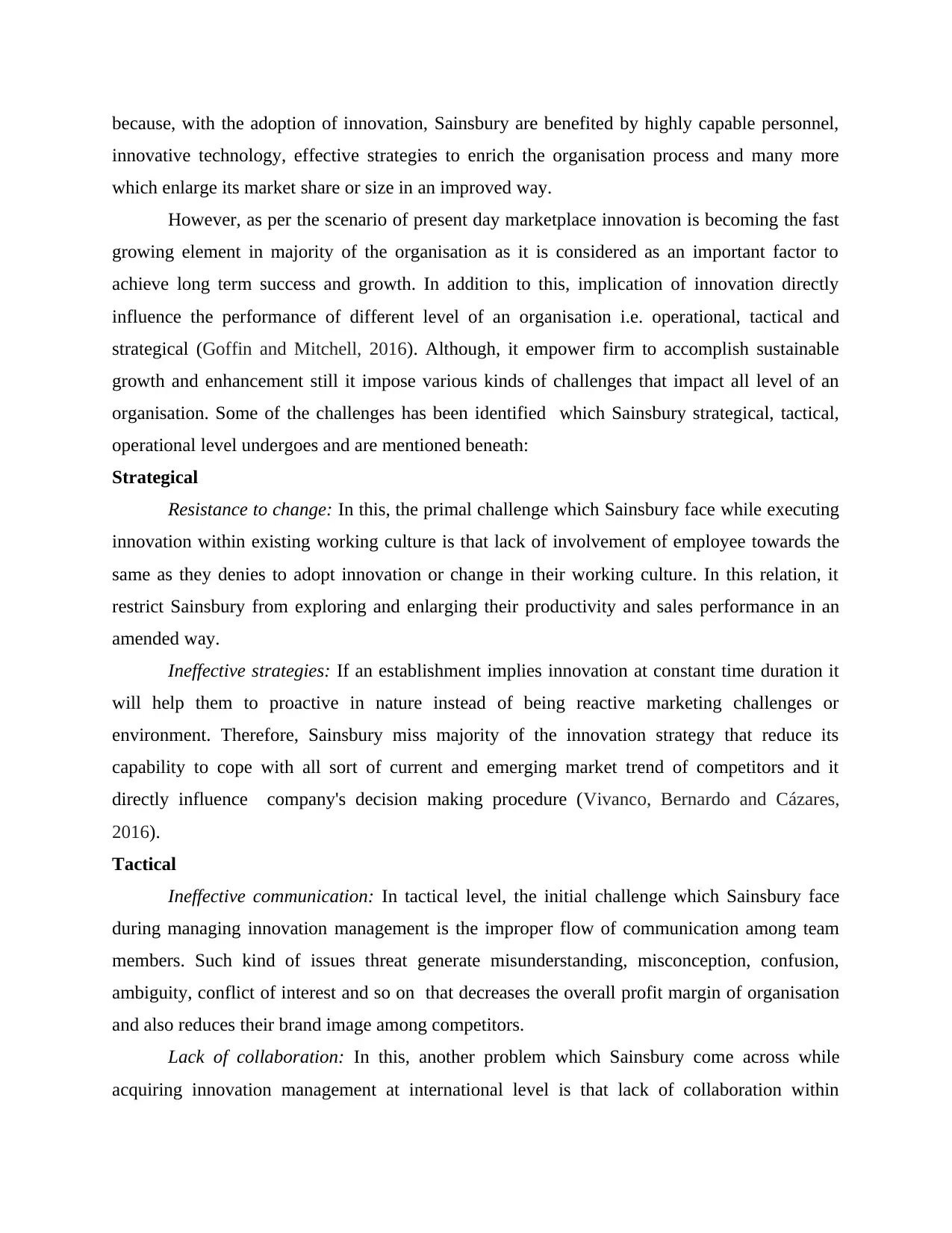
because, with the adoption of innovation, Sainsbury are benefited by highly capable personnel,
innovative technology, effective strategies to enrich the organisation process and many more
which enlarge its market share or size in an improved way.
However, as per the scenario of present day marketplace innovation is becoming the fast
growing element in majority of the organisation as it is considered as an important factor to
achieve long term success and growth. In addition to this, implication of innovation directly
influence the performance of different level of an organisation i.e. operational, tactical and
strategical (Goffin and Mitchell, 2016). Although, it empower firm to accomplish sustainable
growth and enhancement still it impose various kinds of challenges that impact all level of an
organisation. Some of the challenges has been identified which Sainsbury strategical, tactical,
operational level undergoes and are mentioned beneath:
Strategical
Resistance to change: In this, the primal challenge which Sainsbury face while executing
innovation within existing working culture is that lack of involvement of employee towards the
same as they denies to adopt innovation or change in their working culture. In this relation, it
restrict Sainsbury from exploring and enlarging their productivity and sales performance in an
amended way.
Ineffective strategies: If an establishment implies innovation at constant time duration it
will help them to proactive in nature instead of being reactive marketing challenges or
environment. Therefore, Sainsbury miss majority of the innovation strategy that reduce its
capability to cope with all sort of current and emerging market trend of competitors and it
directly influence company's decision making procedure (Vivanco, Bernardo and Cázares,
2016).
Tactical
Ineffective communication: In tactical level, the initial challenge which Sainsbury face
during managing innovation management is the improper flow of communication among team
members. Such kind of issues threat generate misunderstanding, misconception, confusion,
ambiguity, conflict of interest and so on that decreases the overall profit margin of organisation
and also reduces their brand image among competitors.
Lack of collaboration: In this, another problem which Sainsbury come across while
acquiring innovation management at international level is that lack of collaboration within
innovative technology, effective strategies to enrich the organisation process and many more
which enlarge its market share or size in an improved way.
However, as per the scenario of present day marketplace innovation is becoming the fast
growing element in majority of the organisation as it is considered as an important factor to
achieve long term success and growth. In addition to this, implication of innovation directly
influence the performance of different level of an organisation i.e. operational, tactical and
strategical (Goffin and Mitchell, 2016). Although, it empower firm to accomplish sustainable
growth and enhancement still it impose various kinds of challenges that impact all level of an
organisation. Some of the challenges has been identified which Sainsbury strategical, tactical,
operational level undergoes and are mentioned beneath:
Strategical
Resistance to change: In this, the primal challenge which Sainsbury face while executing
innovation within existing working culture is that lack of involvement of employee towards the
same as they denies to adopt innovation or change in their working culture. In this relation, it
restrict Sainsbury from exploring and enlarging their productivity and sales performance in an
amended way.
Ineffective strategies: If an establishment implies innovation at constant time duration it
will help them to proactive in nature instead of being reactive marketing challenges or
environment. Therefore, Sainsbury miss majority of the innovation strategy that reduce its
capability to cope with all sort of current and emerging market trend of competitors and it
directly influence company's decision making procedure (Vivanco, Bernardo and Cázares,
2016).
Tactical
Ineffective communication: In tactical level, the initial challenge which Sainsbury face
during managing innovation management is the improper flow of communication among team
members. Such kind of issues threat generate misunderstanding, misconception, confusion,
ambiguity, conflict of interest and so on that decreases the overall profit margin of organisation
and also reduces their brand image among competitors.
Lack of collaboration: In this, another problem which Sainsbury come across while
acquiring innovation management at international level is that lack of collaboration within
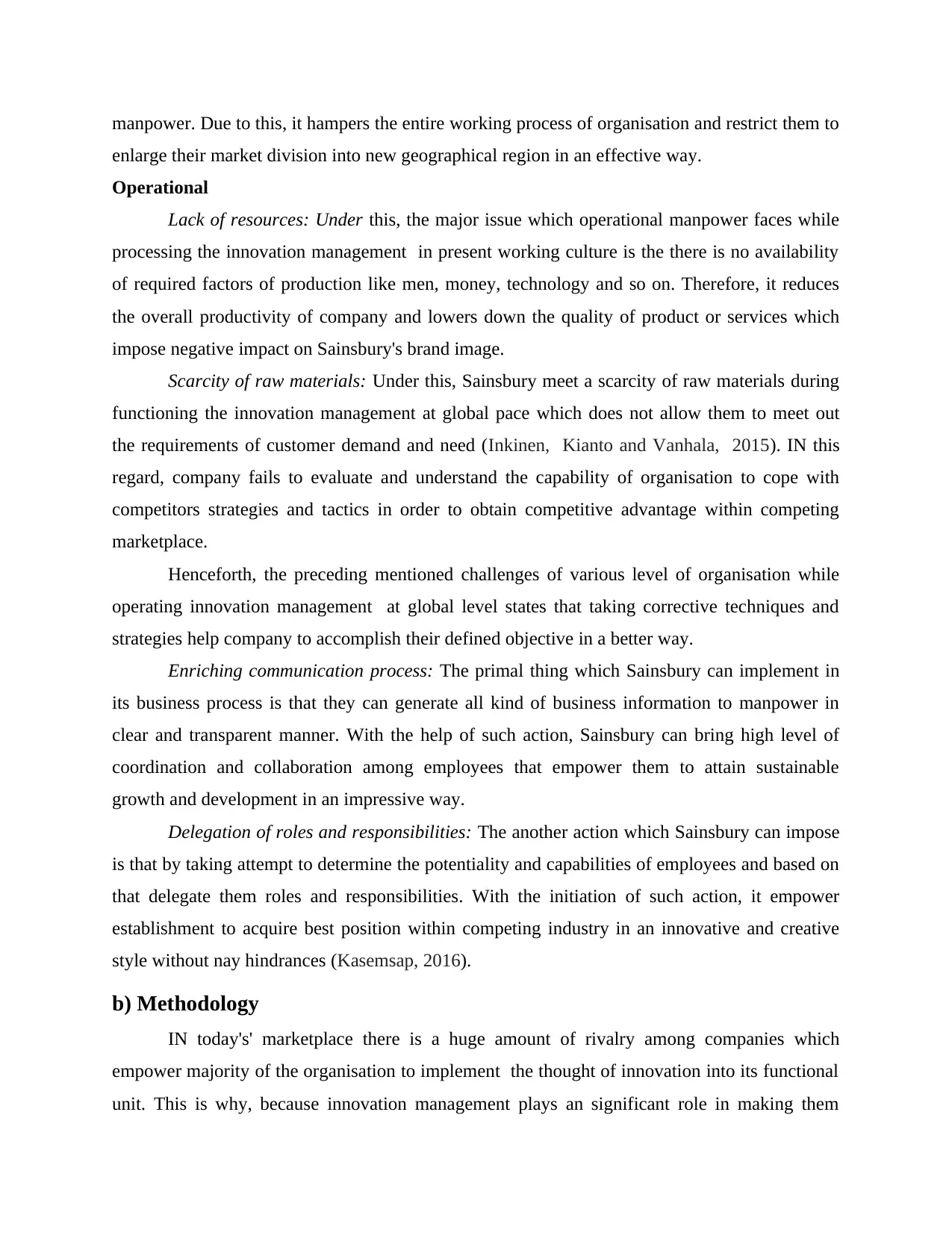
manpower. Due to this, it hampers the entire working process of organisation and restrict them to
enlarge their market division into new geographical region in an effective way.
Operational
Lack of resources: Under this, the major issue which operational manpower faces while
processing the innovation management in present working culture is the there is no availability
of required factors of production like men, money, technology and so on. Therefore, it reduces
the overall productivity of company and lowers down the quality of product or services which
impose negative impact on Sainsbury's brand image.
Scarcity of raw materials: Under this, Sainsbury meet a scarcity of raw materials during
functioning the innovation management at global pace which does not allow them to meet out
the requirements of customer demand and need (Inkinen, Kianto and Vanhala, 2015). IN this
regard, company fails to evaluate and understand the capability of organisation to cope with
competitors strategies and tactics in order to obtain competitive advantage within competing
marketplace.
Henceforth, the preceding mentioned challenges of various level of organisation while
operating innovation management at global level states that taking corrective techniques and
strategies help company to accomplish their defined objective in a better way.
Enriching communication process: The primal thing which Sainsbury can implement in
its business process is that they can generate all kind of business information to manpower in
clear and transparent manner. With the help of such action, Sainsbury can bring high level of
coordination and collaboration among employees that empower them to attain sustainable
growth and development in an impressive way.
Delegation of roles and responsibilities: The another action which Sainsbury can impose
is that by taking attempt to determine the potentiality and capabilities of employees and based on
that delegate them roles and responsibilities. With the initiation of such action, it empower
establishment to acquire best position within competing industry in an innovative and creative
style without nay hindrances (Kasemsap, 2016).
b) Methodology
IN today's' marketplace there is a huge amount of rivalry among companies which
empower majority of the organisation to implement the thought of innovation into its functional
unit. This is why, because innovation management plays an significant role in making them
enlarge their market division into new geographical region in an effective way.
Operational
Lack of resources: Under this, the major issue which operational manpower faces while
processing the innovation management in present working culture is the there is no availability
of required factors of production like men, money, technology and so on. Therefore, it reduces
the overall productivity of company and lowers down the quality of product or services which
impose negative impact on Sainsbury's brand image.
Scarcity of raw materials: Under this, Sainsbury meet a scarcity of raw materials during
functioning the innovation management at global pace which does not allow them to meet out
the requirements of customer demand and need (Inkinen, Kianto and Vanhala, 2015). IN this
regard, company fails to evaluate and understand the capability of organisation to cope with
competitors strategies and tactics in order to obtain competitive advantage within competing
marketplace.
Henceforth, the preceding mentioned challenges of various level of organisation while
operating innovation management at global level states that taking corrective techniques and
strategies help company to accomplish their defined objective in a better way.
Enriching communication process: The primal thing which Sainsbury can implement in
its business process is that they can generate all kind of business information to manpower in
clear and transparent manner. With the help of such action, Sainsbury can bring high level of
coordination and collaboration among employees that empower them to attain sustainable
growth and development in an impressive way.
Delegation of roles and responsibilities: The another action which Sainsbury can impose
is that by taking attempt to determine the potentiality and capabilities of employees and based on
that delegate them roles and responsibilities. With the initiation of such action, it empower
establishment to acquire best position within competing industry in an innovative and creative
style without nay hindrances (Kasemsap, 2016).
b) Methodology
IN today's' marketplace there is a huge amount of rivalry among companies which
empower majority of the organisation to implement the thought of innovation into its functional
unit. This is why, because innovation management plays an significant role in making them
⊘ This is a preview!⊘
Do you want full access?
Subscribe today to unlock all pages.

Trusted by 1+ million students worldwide
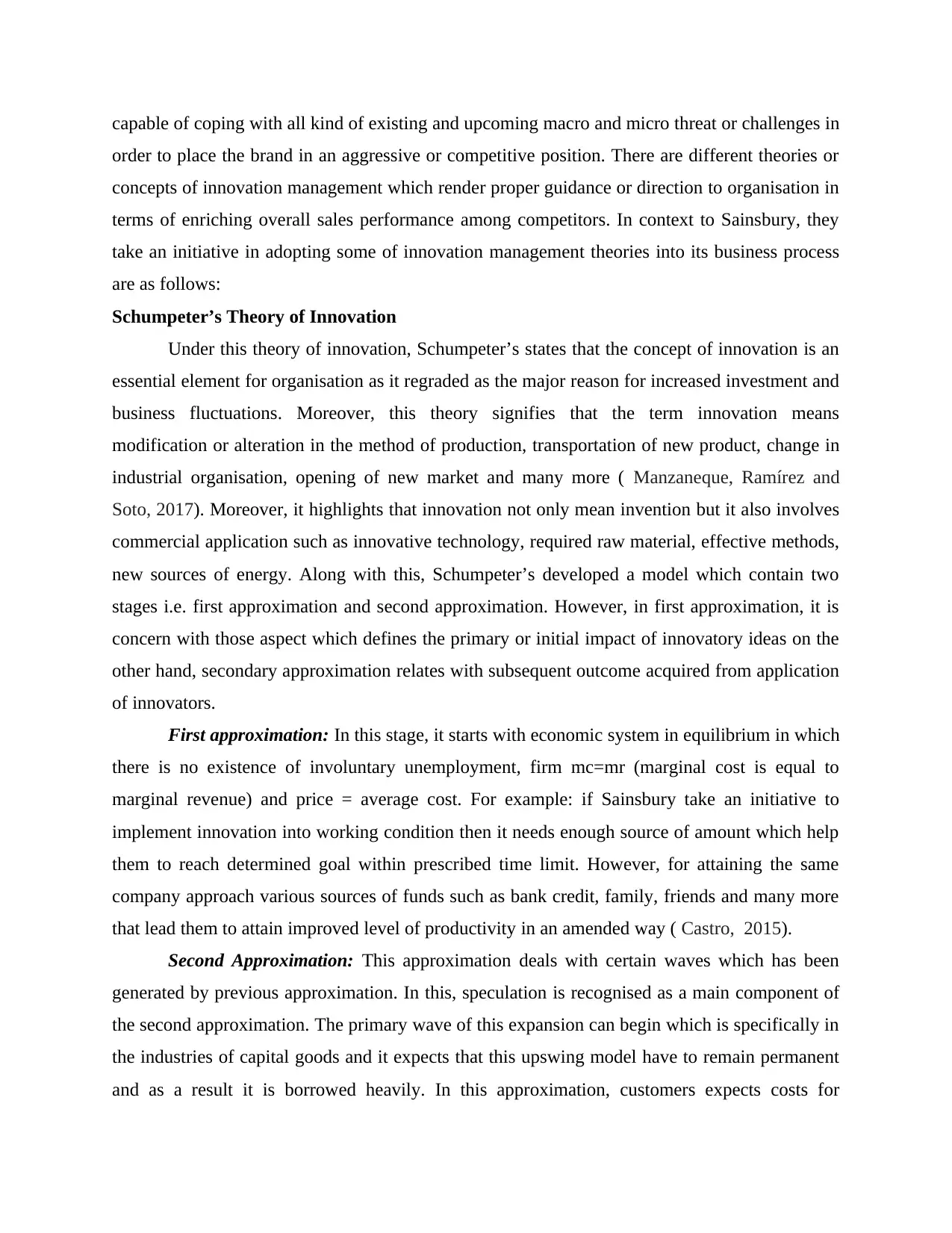
capable of coping with all kind of existing and upcoming macro and micro threat or challenges in
order to place the brand in an aggressive or competitive position. There are different theories or
concepts of innovation management which render proper guidance or direction to organisation in
terms of enriching overall sales performance among competitors. In context to Sainsbury, they
take an initiative in adopting some of innovation management theories into its business process
are as follows:
Schumpeter’s Theory of Innovation
Under this theory of innovation, Schumpeter’s states that the concept of innovation is an
essential element for organisation as it regraded as the major reason for increased investment and
business fluctuations. Moreover, this theory signifies that the term innovation means
modification or alteration in the method of production, transportation of new product, change in
industrial organisation, opening of new market and many more ( Manzaneque, Ramírez and
Soto, 2017). Moreover, it highlights that innovation not only mean invention but it also involves
commercial application such as innovative technology, required raw material, effective methods,
new sources of energy. Along with this, Schumpeter’s developed a model which contain two
stages i.e. first approximation and second approximation. However, in first approximation, it is
concern with those aspect which defines the primary or initial impact of innovatory ideas on the
other hand, secondary approximation relates with subsequent outcome acquired from application
of innovators.
First approximation: In this stage, it starts with economic system in equilibrium in which
there is no existence of involuntary unemployment, firm mc=mr (marginal cost is equal to
marginal revenue) and price = average cost. For example: if Sainsbury take an initiative to
implement innovation into working condition then it needs enough source of amount which help
them to reach determined goal within prescribed time limit. However, for attaining the same
company approach various sources of funds such as bank credit, family, friends and many more
that lead them to attain improved level of productivity in an amended way ( Castro, 2015).
Second Approximation: This approximation deals with certain waves which has been
generated by previous approximation. In this, speculation is recognised as a main component of
the second approximation. The primary wave of this expansion can begin which is specifically in
the industries of capital goods and it expects that this upswing model have to remain permanent
and as a result it is borrowed heavily. In this approximation, customers expects costs for
order to place the brand in an aggressive or competitive position. There are different theories or
concepts of innovation management which render proper guidance or direction to organisation in
terms of enriching overall sales performance among competitors. In context to Sainsbury, they
take an initiative in adopting some of innovation management theories into its business process
are as follows:
Schumpeter’s Theory of Innovation
Under this theory of innovation, Schumpeter’s states that the concept of innovation is an
essential element for organisation as it regraded as the major reason for increased investment and
business fluctuations. Moreover, this theory signifies that the term innovation means
modification or alteration in the method of production, transportation of new product, change in
industrial organisation, opening of new market and many more ( Manzaneque, Ramírez and
Soto, 2017). Moreover, it highlights that innovation not only mean invention but it also involves
commercial application such as innovative technology, required raw material, effective methods,
new sources of energy. Along with this, Schumpeter’s developed a model which contain two
stages i.e. first approximation and second approximation. However, in first approximation, it is
concern with those aspect which defines the primary or initial impact of innovatory ideas on the
other hand, secondary approximation relates with subsequent outcome acquired from application
of innovators.
First approximation: In this stage, it starts with economic system in equilibrium in which
there is no existence of involuntary unemployment, firm mc=mr (marginal cost is equal to
marginal revenue) and price = average cost. For example: if Sainsbury take an initiative to
implement innovation into working condition then it needs enough source of amount which help
them to reach determined goal within prescribed time limit. However, for attaining the same
company approach various sources of funds such as bank credit, family, friends and many more
that lead them to attain improved level of productivity in an amended way ( Castro, 2015).
Second Approximation: This approximation deals with certain waves which has been
generated by previous approximation. In this, speculation is recognised as a main component of
the second approximation. The primary wave of this expansion can begin which is specifically in
the industries of capital goods and it expects that this upswing model have to remain permanent
and as a result it is borrowed heavily. In this approximation, customers expects costs for
Paraphrase This Document
Need a fresh take? Get an instant paraphrase of this document with our AI Paraphraser
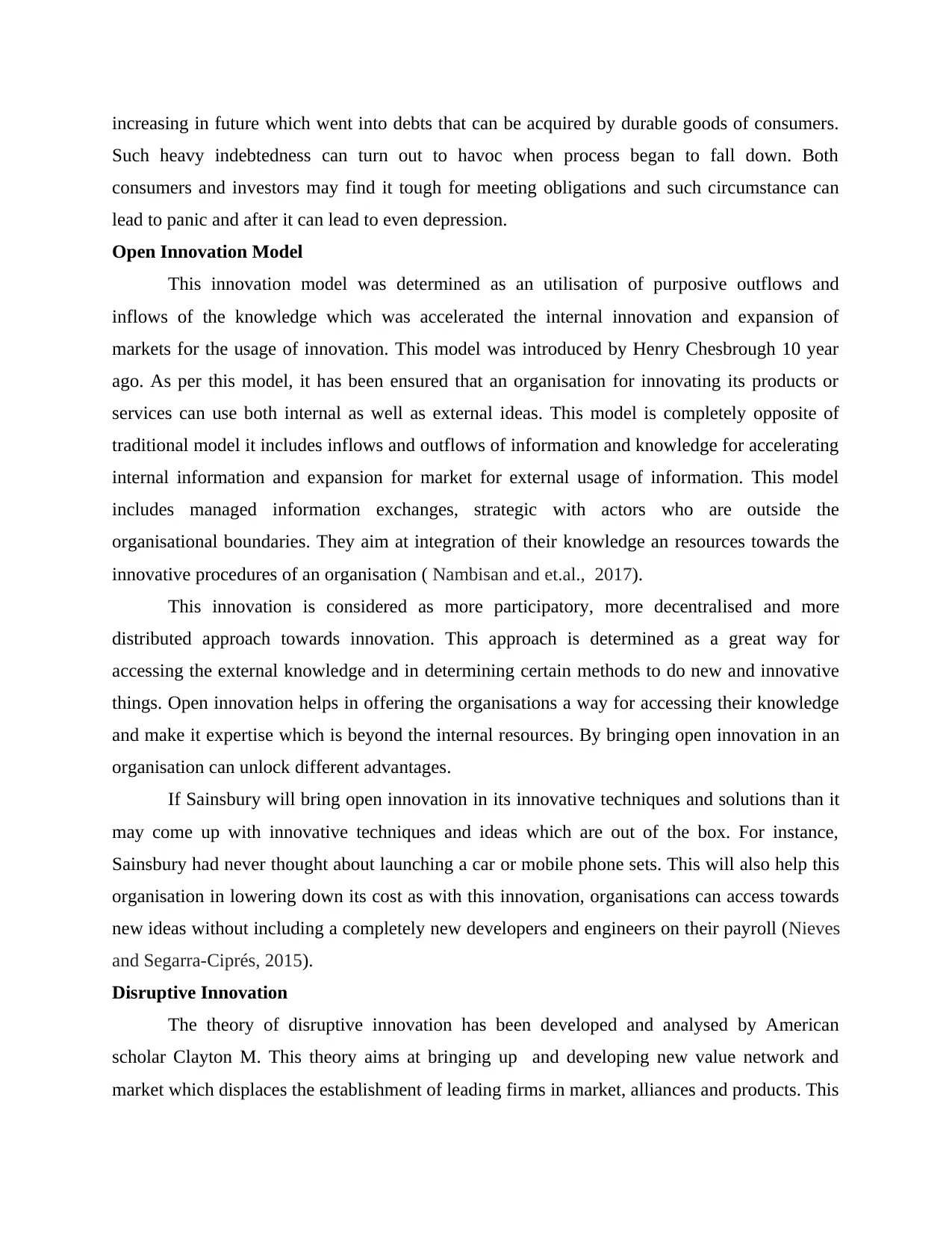
increasing in future which went into debts that can be acquired by durable goods of consumers.
Such heavy indebtedness can turn out to havoc when process began to fall down. Both
consumers and investors may find it tough for meeting obligations and such circumstance can
lead to panic and after it can lead to even depression.
Open Innovation Model
This innovation model was determined as an utilisation of purposive outflows and
inflows of the knowledge which was accelerated the internal innovation and expansion of
markets for the usage of innovation. This model was introduced by Henry Chesbrough 10 year
ago. As per this model, it has been ensured that an organisation for innovating its products or
services can use both internal as well as external ideas. This model is completely opposite of
traditional model it includes inflows and outflows of information and knowledge for accelerating
internal information and expansion for market for external usage of information. This model
includes managed information exchanges, strategic with actors who are outside the
organisational boundaries. They aim at integration of their knowledge an resources towards the
innovative procedures of an organisation ( Nambisan and et.al., 2017).
This innovation is considered as more participatory, more decentralised and more
distributed approach towards innovation. This approach is determined as a great way for
accessing the external knowledge and in determining certain methods to do new and innovative
things. Open innovation helps in offering the organisations a way for accessing their knowledge
and make it expertise which is beyond the internal resources. By bringing open innovation in an
organisation can unlock different advantages.
If Sainsbury will bring open innovation in its innovative techniques and solutions than it
may come up with innovative techniques and ideas which are out of the box. For instance,
Sainsbury had never thought about launching a car or mobile phone sets. This will also help this
organisation in lowering down its cost as with this innovation, organisations can access towards
new ideas without including a completely new developers and engineers on their payroll (Nieves
and Segarra-Ciprés, 2015).
Disruptive Innovation
The theory of disruptive innovation has been developed and analysed by American
scholar Clayton M. This theory aims at bringing up and developing new value network and
market which displaces the establishment of leading firms in market, alliances and products. This
Such heavy indebtedness can turn out to havoc when process began to fall down. Both
consumers and investors may find it tough for meeting obligations and such circumstance can
lead to panic and after it can lead to even depression.
Open Innovation Model
This innovation model was determined as an utilisation of purposive outflows and
inflows of the knowledge which was accelerated the internal innovation and expansion of
markets for the usage of innovation. This model was introduced by Henry Chesbrough 10 year
ago. As per this model, it has been ensured that an organisation for innovating its products or
services can use both internal as well as external ideas. This model is completely opposite of
traditional model it includes inflows and outflows of information and knowledge for accelerating
internal information and expansion for market for external usage of information. This model
includes managed information exchanges, strategic with actors who are outside the
organisational boundaries. They aim at integration of their knowledge an resources towards the
innovative procedures of an organisation ( Nambisan and et.al., 2017).
This innovation is considered as more participatory, more decentralised and more
distributed approach towards innovation. This approach is determined as a great way for
accessing the external knowledge and in determining certain methods to do new and innovative
things. Open innovation helps in offering the organisations a way for accessing their knowledge
and make it expertise which is beyond the internal resources. By bringing open innovation in an
organisation can unlock different advantages.
If Sainsbury will bring open innovation in its innovative techniques and solutions than it
may come up with innovative techniques and ideas which are out of the box. For instance,
Sainsbury had never thought about launching a car or mobile phone sets. This will also help this
organisation in lowering down its cost as with this innovation, organisations can access towards
new ideas without including a completely new developers and engineers on their payroll (Nieves
and Segarra-Ciprés, 2015).
Disruptive Innovation
The theory of disruptive innovation has been developed and analysed by American
scholar Clayton M. This theory aims at bringing up and developing new value network and
market which displaces the establishment of leading firms in market, alliances and products. This
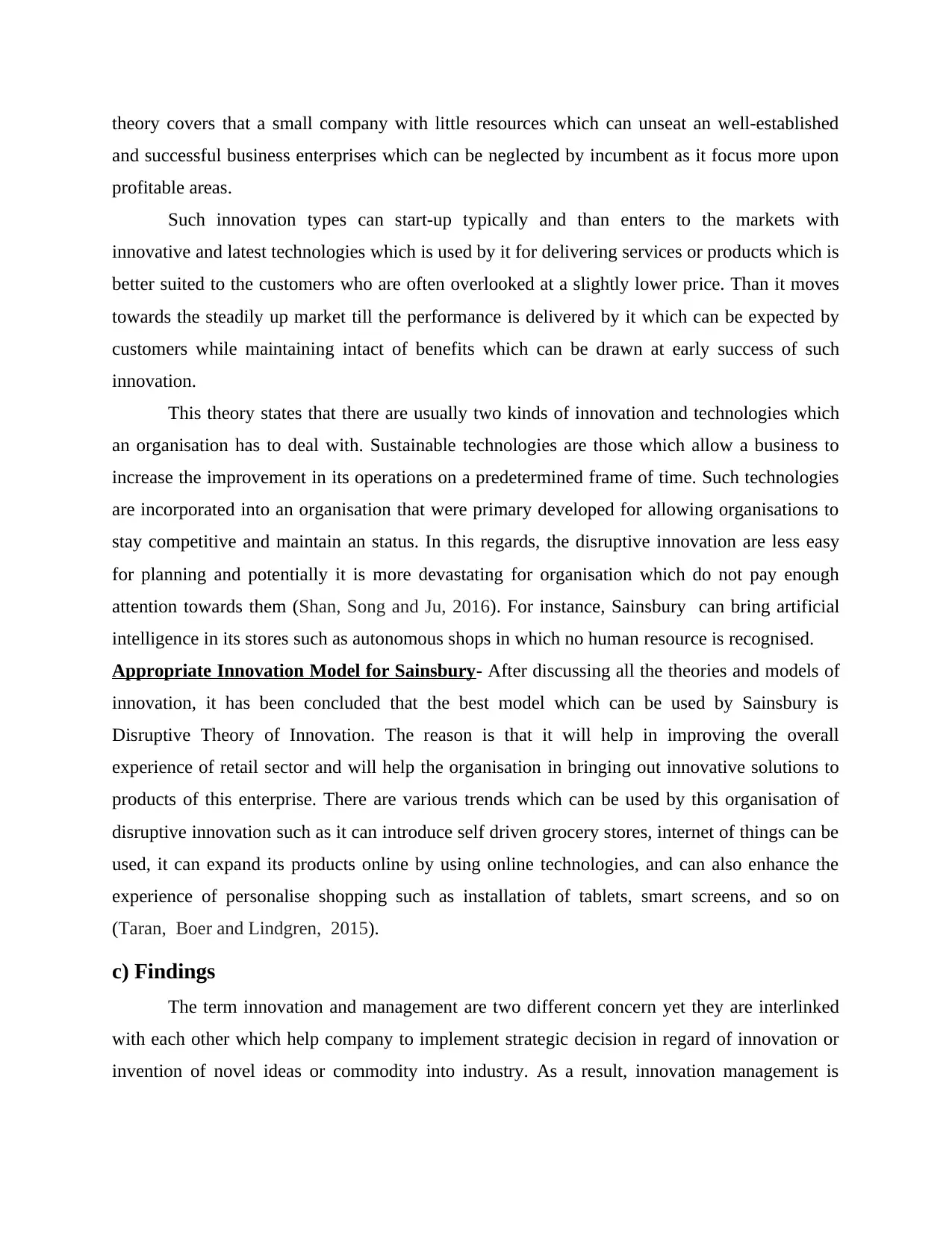
theory covers that a small company with little resources which can unseat an well-established
and successful business enterprises which can be neglected by incumbent as it focus more upon
profitable areas.
Such innovation types can start-up typically and than enters to the markets with
innovative and latest technologies which is used by it for delivering services or products which is
better suited to the customers who are often overlooked at a slightly lower price. Than it moves
towards the steadily up market till the performance is delivered by it which can be expected by
customers while maintaining intact of benefits which can be drawn at early success of such
innovation.
This theory states that there are usually two kinds of innovation and technologies which
an organisation has to deal with. Sustainable technologies are those which allow a business to
increase the improvement in its operations on a predetermined frame of time. Such technologies
are incorporated into an organisation that were primary developed for allowing organisations to
stay competitive and maintain an status. In this regards, the disruptive innovation are less easy
for planning and potentially it is more devastating for organisation which do not pay enough
attention towards them (Shan, Song and Ju, 2016). For instance, Sainsbury can bring artificial
intelligence in its stores such as autonomous shops in which no human resource is recognised.
Appropriate Innovation Model for Sainsbury- After discussing all the theories and models of
innovation, it has been concluded that the best model which can be used by Sainsbury is
Disruptive Theory of Innovation. The reason is that it will help in improving the overall
experience of retail sector and will help the organisation in bringing out innovative solutions to
products of this enterprise. There are various trends which can be used by this organisation of
disruptive innovation such as it can introduce self driven grocery stores, internet of things can be
used, it can expand its products online by using online technologies, and can also enhance the
experience of personalise shopping such as installation of tablets, smart screens, and so on
(Taran, Boer and Lindgren, 2015).
c) Findings
The term innovation and management are two different concern yet they are interlinked
with each other which help company to implement strategic decision in regard of innovation or
invention of novel ideas or commodity into industry. As a result, innovation management is
and successful business enterprises which can be neglected by incumbent as it focus more upon
profitable areas.
Such innovation types can start-up typically and than enters to the markets with
innovative and latest technologies which is used by it for delivering services or products which is
better suited to the customers who are often overlooked at a slightly lower price. Than it moves
towards the steadily up market till the performance is delivered by it which can be expected by
customers while maintaining intact of benefits which can be drawn at early success of such
innovation.
This theory states that there are usually two kinds of innovation and technologies which
an organisation has to deal with. Sustainable technologies are those which allow a business to
increase the improvement in its operations on a predetermined frame of time. Such technologies
are incorporated into an organisation that were primary developed for allowing organisations to
stay competitive and maintain an status. In this regards, the disruptive innovation are less easy
for planning and potentially it is more devastating for organisation which do not pay enough
attention towards them (Shan, Song and Ju, 2016). For instance, Sainsbury can bring artificial
intelligence in its stores such as autonomous shops in which no human resource is recognised.
Appropriate Innovation Model for Sainsbury- After discussing all the theories and models of
innovation, it has been concluded that the best model which can be used by Sainsbury is
Disruptive Theory of Innovation. The reason is that it will help in improving the overall
experience of retail sector and will help the organisation in bringing out innovative solutions to
products of this enterprise. There are various trends which can be used by this organisation of
disruptive innovation such as it can introduce self driven grocery stores, internet of things can be
used, it can expand its products online by using online technologies, and can also enhance the
experience of personalise shopping such as installation of tablets, smart screens, and so on
(Taran, Boer and Lindgren, 2015).
c) Findings
The term innovation and management are two different concern yet they are interlinked
with each other which help company to implement strategic decision in regard of innovation or
invention of novel ideas or commodity into industry. As a result, innovation management is
⊘ This is a preview!⊘
Do you want full access?
Subscribe today to unlock all pages.

Trusted by 1+ million students worldwide
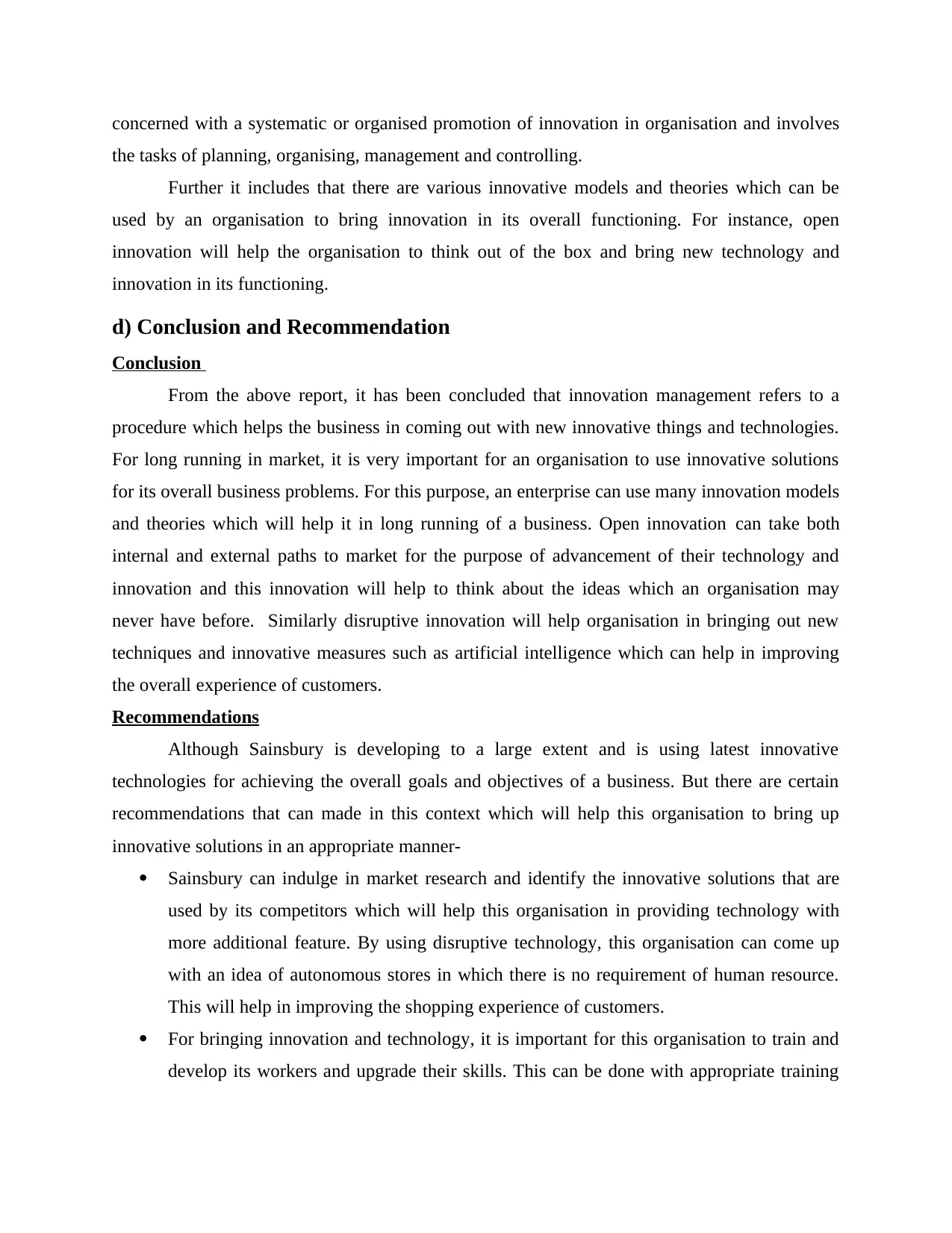
concerned with a systematic or organised promotion of innovation in organisation and involves
the tasks of planning, organising, management and controlling.
Further it includes that there are various innovative models and theories which can be
used by an organisation to bring innovation in its overall functioning. For instance, open
innovation will help the organisation to think out of the box and bring new technology and
innovation in its functioning.
d) Conclusion and Recommendation
Conclusion
From the above report, it has been concluded that innovation management refers to a
procedure which helps the business in coming out with new innovative things and technologies.
For long running in market, it is very important for an organisation to use innovative solutions
for its overall business problems. For this purpose, an enterprise can use many innovation models
and theories which will help it in long running of a business. Open innovation can take both
internal and external paths to market for the purpose of advancement of their technology and
innovation and this innovation will help to think about the ideas which an organisation may
never have before. Similarly disruptive innovation will help organisation in bringing out new
techniques and innovative measures such as artificial intelligence which can help in improving
the overall experience of customers.
Recommendations
Although Sainsbury is developing to a large extent and is using latest innovative
technologies for achieving the overall goals and objectives of a business. But there are certain
recommendations that can made in this context which will help this organisation to bring up
innovative solutions in an appropriate manner-
Sainsbury can indulge in market research and identify the innovative solutions that are
used by its competitors which will help this organisation in providing technology with
more additional feature. By using disruptive technology, this organisation can come up
with an idea of autonomous stores in which there is no requirement of human resource.
This will help in improving the shopping experience of customers.
For bringing innovation and technology, it is important for this organisation to train and
develop its workers and upgrade their skills. This can be done with appropriate training
the tasks of planning, organising, management and controlling.
Further it includes that there are various innovative models and theories which can be
used by an organisation to bring innovation in its overall functioning. For instance, open
innovation will help the organisation to think out of the box and bring new technology and
innovation in its functioning.
d) Conclusion and Recommendation
Conclusion
From the above report, it has been concluded that innovation management refers to a
procedure which helps the business in coming out with new innovative things and technologies.
For long running in market, it is very important for an organisation to use innovative solutions
for its overall business problems. For this purpose, an enterprise can use many innovation models
and theories which will help it in long running of a business. Open innovation can take both
internal and external paths to market for the purpose of advancement of their technology and
innovation and this innovation will help to think about the ideas which an organisation may
never have before. Similarly disruptive innovation will help organisation in bringing out new
techniques and innovative measures such as artificial intelligence which can help in improving
the overall experience of customers.
Recommendations
Although Sainsbury is developing to a large extent and is using latest innovative
technologies for achieving the overall goals and objectives of a business. But there are certain
recommendations that can made in this context which will help this organisation to bring up
innovative solutions in an appropriate manner-
Sainsbury can indulge in market research and identify the innovative solutions that are
used by its competitors which will help this organisation in providing technology with
more additional feature. By using disruptive technology, this organisation can come up
with an idea of autonomous stores in which there is no requirement of human resource.
This will help in improving the shopping experience of customers.
For bringing innovation and technology, it is important for this organisation to train and
develop its workers and upgrade their skills. This can be done with appropriate training
Paraphrase This Document
Need a fresh take? Get an instant paraphrase of this document with our AI Paraphraser
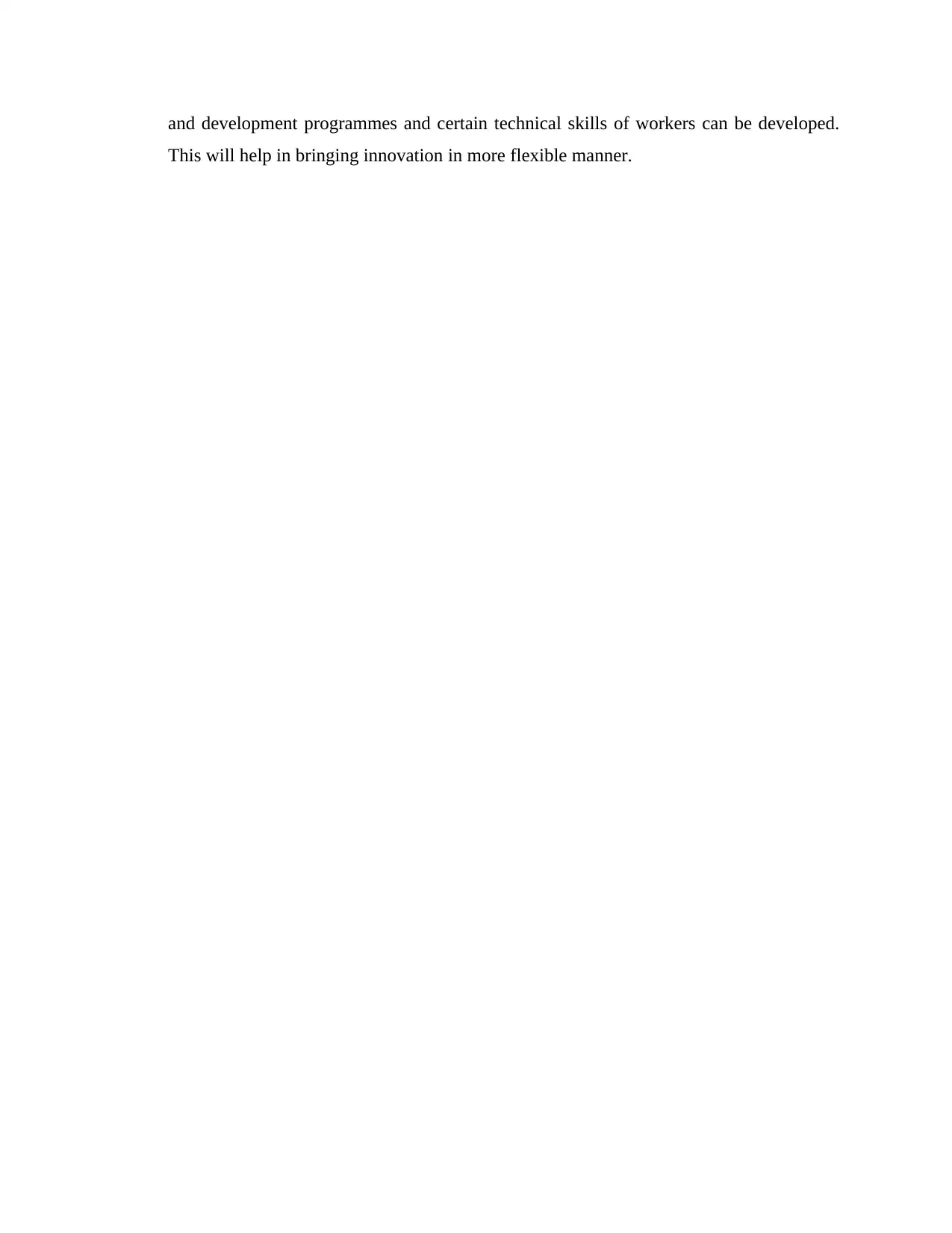
and development programmes and certain technical skills of workers can be developed.
This will help in bringing innovation in more flexible manner.
This will help in bringing innovation in more flexible manner.
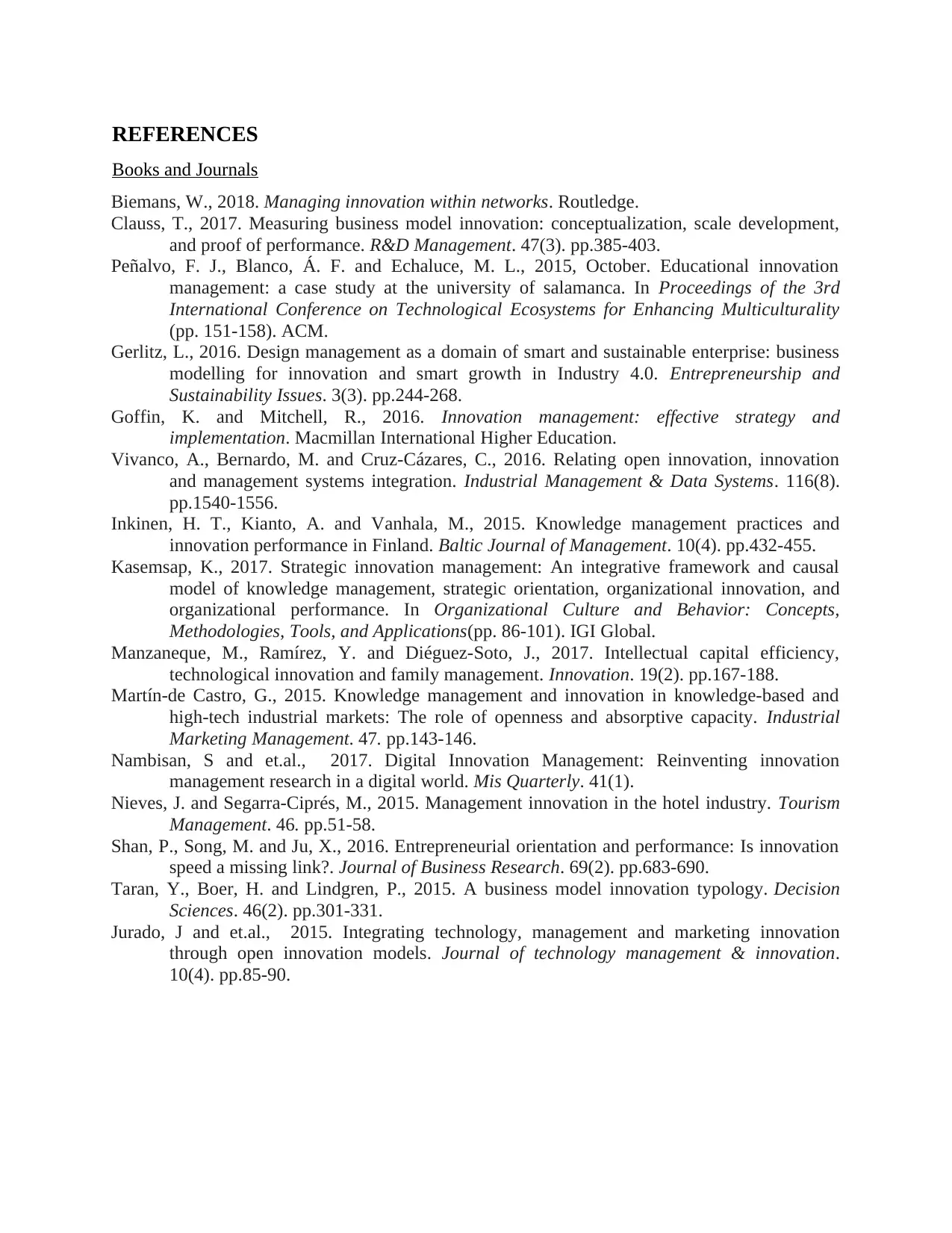
REFERENCES
Books and Journals
Biemans, W., 2018. Managing innovation within networks. Routledge.
Clauss, T., 2017. Measuring business model innovation: conceptualization, scale development,
and proof of performance. R&D Management. 47(3). pp.385-403.
Peñalvo, F. J., Blanco, Á. F. and Echaluce, M. L., 2015, October. Educational innovation
management: a case study at the university of salamanca. In Proceedings of the 3rd
International Conference on Technological Ecosystems for Enhancing Multiculturality
(pp. 151-158). ACM.
Gerlitz, L., 2016. Design management as a domain of smart and sustainable enterprise: business
modelling for innovation and smart growth in Industry 4.0. Entrepreneurship and
Sustainability Issues. 3(3). pp.244-268.
Goffin, K. and Mitchell, R., 2016. Innovation management: effective strategy and
implementation. Macmillan International Higher Education.
Vivanco, A., Bernardo, M. and Cruz-Cázares, C., 2016. Relating open innovation, innovation
and management systems integration. Industrial Management & Data Systems. 116(8).
pp.1540-1556.
Inkinen, H. T., Kianto, A. and Vanhala, M., 2015. Knowledge management practices and
innovation performance in Finland. Baltic Journal of Management. 10(4). pp.432-455.
Kasemsap, K., 2017. Strategic innovation management: An integrative framework and causal
model of knowledge management, strategic orientation, organizational innovation, and
organizational performance. In Organizational Culture and Behavior: Concepts,
Methodologies, Tools, and Applications(pp. 86-101). IGI Global.
Manzaneque, M., Ramírez, Y. and Diéguez-Soto, J., 2017. Intellectual capital efficiency,
technological innovation and family management. Innovation. 19(2). pp.167-188.
Martín-de Castro, G., 2015. Knowledge management and innovation in knowledge-based and
high-tech industrial markets: The role of openness and absorptive capacity. Industrial
Marketing Management. 47. pp.143-146.
Nambisan, S and et.al., 2017. Digital Innovation Management: Reinventing innovation
management research in a digital world. Mis Quarterly. 41(1).
Nieves, J. and Segarra-Ciprés, M., 2015. Management innovation in the hotel industry. Tourism
Management. 46. pp.51-58.
Shan, P., Song, M. and Ju, X., 2016. Entrepreneurial orientation and performance: Is innovation
speed a missing link?. Journal of Business Research. 69(2). pp.683-690.
Taran, Y., Boer, H. and Lindgren, P., 2015. A business model innovation typology. Decision
Sciences. 46(2). pp.301-331.
Jurado, J and et.al., 2015. Integrating technology, management and marketing innovation
through open innovation models. Journal of technology management & innovation.
10(4). pp.85-90.
Books and Journals
Biemans, W., 2018. Managing innovation within networks. Routledge.
Clauss, T., 2017. Measuring business model innovation: conceptualization, scale development,
and proof of performance. R&D Management. 47(3). pp.385-403.
Peñalvo, F. J., Blanco, Á. F. and Echaluce, M. L., 2015, October. Educational innovation
management: a case study at the university of salamanca. In Proceedings of the 3rd
International Conference on Technological Ecosystems for Enhancing Multiculturality
(pp. 151-158). ACM.
Gerlitz, L., 2016. Design management as a domain of smart and sustainable enterprise: business
modelling for innovation and smart growth in Industry 4.0. Entrepreneurship and
Sustainability Issues. 3(3). pp.244-268.
Goffin, K. and Mitchell, R., 2016. Innovation management: effective strategy and
implementation. Macmillan International Higher Education.
Vivanco, A., Bernardo, M. and Cruz-Cázares, C., 2016. Relating open innovation, innovation
and management systems integration. Industrial Management & Data Systems. 116(8).
pp.1540-1556.
Inkinen, H. T., Kianto, A. and Vanhala, M., 2015. Knowledge management practices and
innovation performance in Finland. Baltic Journal of Management. 10(4). pp.432-455.
Kasemsap, K., 2017. Strategic innovation management: An integrative framework and causal
model of knowledge management, strategic orientation, organizational innovation, and
organizational performance. In Organizational Culture and Behavior: Concepts,
Methodologies, Tools, and Applications(pp. 86-101). IGI Global.
Manzaneque, M., Ramírez, Y. and Diéguez-Soto, J., 2017. Intellectual capital efficiency,
technological innovation and family management. Innovation. 19(2). pp.167-188.
Martín-de Castro, G., 2015. Knowledge management and innovation in knowledge-based and
high-tech industrial markets: The role of openness and absorptive capacity. Industrial
Marketing Management. 47. pp.143-146.
Nambisan, S and et.al., 2017. Digital Innovation Management: Reinventing innovation
management research in a digital world. Mis Quarterly. 41(1).
Nieves, J. and Segarra-Ciprés, M., 2015. Management innovation in the hotel industry. Tourism
Management. 46. pp.51-58.
Shan, P., Song, M. and Ju, X., 2016. Entrepreneurial orientation and performance: Is innovation
speed a missing link?. Journal of Business Research. 69(2). pp.683-690.
Taran, Y., Boer, H. and Lindgren, P., 2015. A business model innovation typology. Decision
Sciences. 46(2). pp.301-331.
Jurado, J and et.al., 2015. Integrating technology, management and marketing innovation
through open innovation models. Journal of technology management & innovation.
10(4). pp.85-90.
⊘ This is a preview!⊘
Do you want full access?
Subscribe today to unlock all pages.

Trusted by 1+ million students worldwide
1 out of 12
Related Documents
Your All-in-One AI-Powered Toolkit for Academic Success.
+13062052269
info@desklib.com
Available 24*7 on WhatsApp / Email
![[object Object]](/_next/static/media/star-bottom.7253800d.svg)
Unlock your academic potential
Copyright © 2020–2025 A2Z Services. All Rights Reserved. Developed and managed by ZUCOL.





